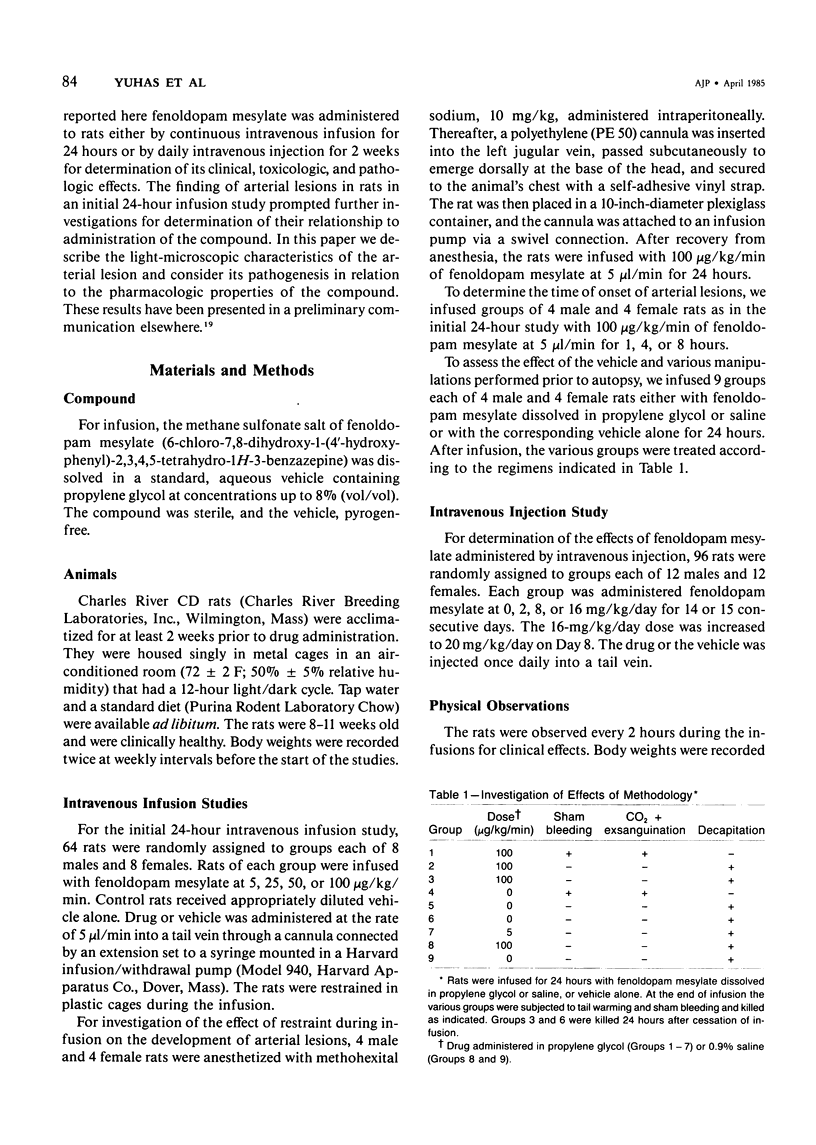Abstract
Fenoldopam mesylate, a selective, postsynaptic, dopaminergic vasodilator, was administered to rats for assessment of its clinical, toxicologic, and pathologic effects. Groups of 8 male and 8 female rats received 5, 25, 50, or 100 micrograms/kg/min by intravenous infusion for 24 hours. Groups of 12 male and 12 female rats received 2, 8, 16, or 20 mg/kg/day by intravenous injection once daily for 12 days. Tissues were examined by light microscopy. Rats infused for 24-hours with 5-100 micrograms/kg/min of fenoldopam had lesions of renal and splanchnic arteries characterized by medial necrosis and hemorrhage. None were seen in control rats or those administered the compound by intravenous injection. Arteries with four to five layers of medial smooth-muscle cells were most severely and frequently affected. Lesions were particularly severe in interlobular pancreatic arteries and subserosal gastric arteries. They occurred first at 4 hours, were present at low incidence at 8 hours, were induced in unrestrained rats, and were not caused by the experimental procedures employed. The nature and disposition of this novel arterial lesion in the rat suggests that its pathogenesis may be related to the pharmacologic activity of fenoldopam mesylate at the dopamine receptor.
Full text
PDF








Images in this article
Selected References
These references are in PubMed. This may not be the complete list of references from this article.
- Anwar N., Mason D. F. Actions of dopamine and apomorphine on the vasoconstrictor responses of perfused mesenteric arteries of mouse, rat and rabbit. J Pharm Pharmacol. 1981 Mar;33(3):150–154. doi: 10.1111/j.2042-7158.1981.tb13738.x. [DOI] [PubMed] [Google Scholar]
- Brodde O. E. Vascular dopamine receptors: Demonstration and characterization by in vitro studies. Life Sci. 1982 Jul 26;31(4):289–306. doi: 10.1016/0024-3205(82)90406-4. [DOI] [PubMed] [Google Scholar]
- Chapman B. J., Horn N. M., Munday K. A., Robertson M. J. The actions of dopamine and of sulpiride on regional blood flows in the rat kidney. J Physiol. 1980 Jan;298:437–452. doi: 10.1113/jphysiol.1980.sp013093. [DOI] [PMC free article] [PubMed] [Google Scholar]
- Creese I., Snyder S. H. Dopamine receptor binding of 3H-ADTN (2-amino-6,7-dihydroxy-1,2,3,4-tetrahydronaphthalene) regulated by guanyl nucleotides. Eur J Pharmacol. 1978 Aug 15;50(4):459–461. doi: 10.1016/0014-2999(78)90156-5. [DOI] [PubMed] [Google Scholar]
- Gardner D. L., Matthews M. A. Ultrastructure of the wall of small arteries in early experimental rat hypertension. J Pathol. 1969 Jan;97(1):51–62. doi: 10.1002/path.1710970108. [DOI] [PubMed] [Google Scholar]
- Goldberg L. I. Cardiovascular and renal actions of dopamine: potential clinical applications. Pharmacol Rev. 1972 Mar;24(1):1–29. [PubMed] [Google Scholar]
- Hahn R. A., Wardell J. R., Jr Renal vascular activity of SK&F 38393 and dopamine in anesthetized dogs. J Cardiovasc Pharmacol. 1980 Sep-Oct;2(5):583–593. doi: 10.1097/00005344-198009000-00008. [DOI] [PubMed] [Google Scholar]
- Hahn R. A., Wardell J. R., Jr, Sarau H. M., Ridley P. T. Characterization of the peripheral and central effects of SK&F 82526, a novel dopamine receptor agonist. J Pharmacol Exp Ther. 1982 Nov;223(2):305–313. [PubMed] [Google Scholar]
- Iversen L. L. Dopamine receptors in the brain. Science. 1975 Jun 13;188(4193):1084–1089. doi: 10.1126/science.2976. [DOI] [PubMed] [Google Scholar]
- Joris I., Majno G. Medial changes in arterial spasm induced by L-norepinephrine. Am J Pathol. 1981 Dec;105(3):212–222. [PMC free article] [PubMed] [Google Scholar]
- Kaiser C., Ali F. E., Bondinell W. E., Brenner M., Holden K. G., Ku T. W., Oh H. J., Ross S. T., Yim N. C., Zirkle C. L. 6-(Phenylthio)-substituted 2,3,4,5-tetrahydro-1H-3-benzazepines, a novel class of dopamine receptor antagonists and neuroleptics. J Med Chem. 1980 Sep;23(9):975–976. doi: 10.1021/jm00183a002. [DOI] [PubMed] [Google Scholar]
- Kano K., Milgrom F. Immune complex disease. Vox Sang. 1980;38(3):121–137. doi: 10.1111/j.1423-0410.1980.tb02340.x. [DOI] [PubMed] [Google Scholar]
- Nemes Z., Dietz R., Mann J. F., Lüth J. B., Gross F. Vasoconstriction and increased blood pressure in the development of accelerated vascular disease. Virchows Arch A Pathol Anat Histol. 1980;386(2):161–173. doi: 10.1007/BF00427228. [DOI] [PubMed] [Google Scholar]
- Pendleton R. G., Samler L., Kaiser C., Ridley P. T. Studies on renal dopamine receptors with a new agonist. Eur J Pharmacol. 1978 Sep 1;51(1):19–28. doi: 10.1016/0014-2999(78)90057-2. [DOI] [PubMed] [Google Scholar]
- Pfeiffer F. R., Wilson J. W., Weinstock J., Kuo G. Y., Chambers P. A., Holden K. G., Hahn R. A., Wardell J. R., Jr, Tobia A. J., Setler P. E. Dopaminergic activity of substituted 6-chloro-1-phenyl-2,3,4,5-tetrahydro-1H-3-benzazepines. J Med Chem. 1982 Apr;25(4):352–358. doi: 10.1021/jm00346a005. [DOI] [PubMed] [Google Scholar]
- Raute-Kreinsen U., Stier H., Lehmann W., Kachel W. Dopamin-induzierte sekundäre Cardiomyopathie. Virchows Arch A Pathol Anat Histol. 1980;388(1):77–85. doi: 10.1007/BF00430678. [DOI] [PubMed] [Google Scholar]
- Schmidt M., Imbs J. L. Pharmacological characterization of renal vascular dopamine receptors. J Cardiovasc Pharmacol. 1980 Sep-Oct;2(5):595–605. doi: 10.1097/00005344-198009000-00009. [DOI] [PubMed] [Google Scholar]
- Setler P. E., Pendleton R. G., Finlay E. The cardiovascular actions of dopamine and the effects of central and peripheral catecholaminergic receptor blocking drugs. J Pharmacol Exp Ther. 1975 Mar;192(3):702–712. [PubMed] [Google Scholar]
- Setler P. E., Sarau H. M., Zirkle C. L., Saunders H. L. The central effects of a novel dopamine agonist. Eur J Pharmacol. 1978 Aug 15;50(4):419–430. doi: 10.1016/0014-2999(78)90148-6. [DOI] [PubMed] [Google Scholar]
- Tanaka M. Electron microscopic study of cardiac lesions induced in rats by isoproterenol and by repeated stress. With suggestion that idiopathic cardiomyopathy may be a "disease of adaptation". Jpn Circ J. 1981 Dec;45(12):1342–1354. doi: 10.1253/jcj.45.1342. [DOI] [PubMed] [Google Scholar]
- Weinstock J., Wilson J. W., Ladd D. L., Brush C. K., Pfeiffer F. R., Kuo G. Y., Holden K. G., Yim N. C., Hahn R. A., Wardell J. R., Jr Separation of potent central and renal dopamine agonist activity in substituted 6-chloro-2,3,4,5-tetrahydro-7,8-dihydroxy-1-phenyl-1H-3-benzazepines. J Med Chem. 1980 Sep;23(9):973–975. doi: 10.1021/jm00183a001. [DOI] [PubMed] [Google Scholar]
- Wexler B. C. Arterial lesions and hypertension induced by saline, unilateral nephrectomy, and deoxycorticosterone in spontaneously hypertensive SHR rats. Paroi Arterielle. 1979 Jul;5(2):99–113. [PubMed] [Google Scholar]
- Wexler B. C. Corticotropin stimulation of hypertensive rats with and without arteriosclerosis. Arch Pathol Lab Med. 1978 Nov;102(11):587–591. [PubMed] [Google Scholar]






